Photography on Tour: Themes of the 1970s and 80s in the Half Moon Photography Workshop Touring Exhibitions
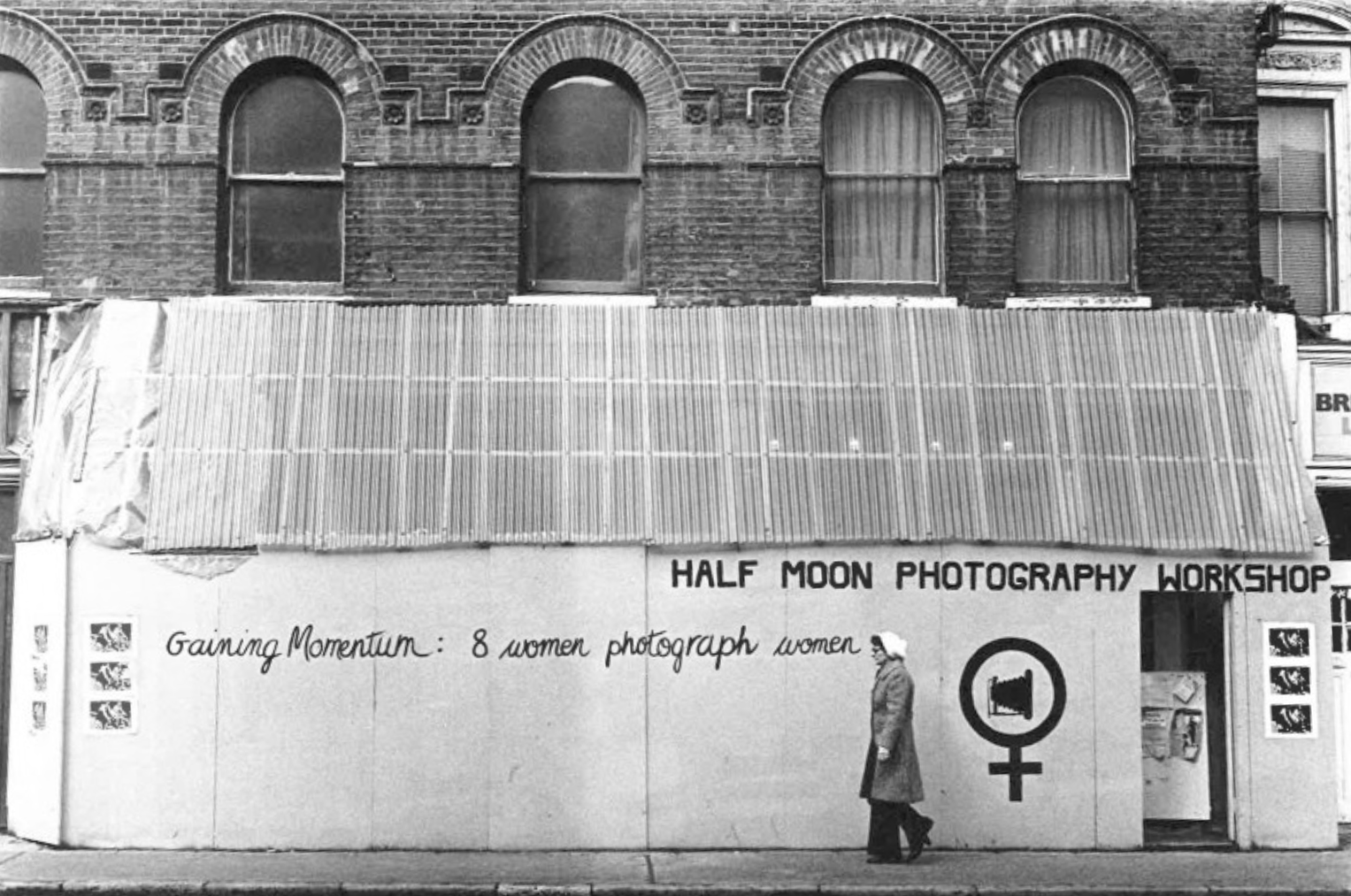
By Jayne Knight
Between 1976 and the mid-eighties, the Half Moon Photography Workshop ran an innovative touring exhibition programme that changed how photography was disseminated, as explored in a previous blog post. In this article, I will take a closer look at some of the touring exhibitions that were available for hire, and the themes that emerged from visual engagement with the socio-political landscape of the era.
In 1975, the Half Moon Gallery and the Photography Workshop merged to become the Half Moon Photography Workshop (HMPW), and shortly began publishing Camerawork, a magazine which described itself in its first issue as “a forum for the exchange of ideas on photography and other forms of photography”. From the second issue of Camerawork, touring exhibitions available for hire were advertised, and new exhibitions promoted in further issues were often connected to editorial features on the same theme or title. This included Who Killed Blair Peach? (1979), an examination of the death of an anti-fascist campaigner in Southall, and the growing concern over police accountability, with the article and accompanying exhibition considering the bigger question of “who polices the police?”. Interest from further education institutions in this exhibition’s themes of campaign, democracy and conservative policies is demonstrated in its first bookings: the exhibition travelled from the University of Glasgow to the University of Liverpool, and then to a London University between September 1980 and January 1981.
May 1975; The 'Men by Women' exhibition in its touring box in Mike Goldwater's studio in Chalk Farm, London. Photo by Mike Goldwater
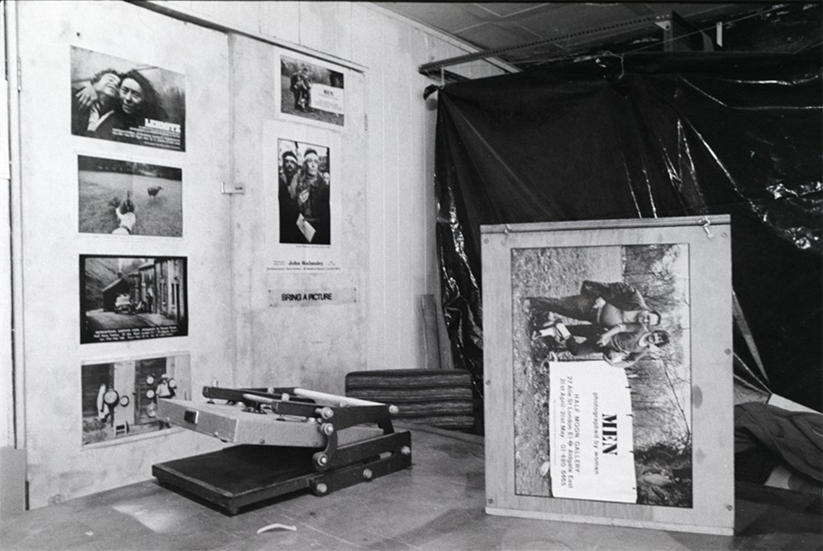
In addition to Camerawork magazine, touring exhibition booklets were also produced for distribution amongst prospective venues, providing short, descriptive accounts of the exhibitions and practical information on the number of photographs, panels and their dimensions. Exhibitions were packaged and posted to all corners of the UK: from London to Bristol and Bangor, the Shetland Islands and Newcastle, with several bookings coming from as far as Germany.
Although historical events featured in the touring programme with exhibitions like London Blitz (1981), noted by Half Moon Photography Workshop as being of local interest, most touring exhibition themes had contemporary relevance, such as The Thirties and Today (1977). Exhibitions often responded to current events and movements, while addressing issues of representation, identity, equality and social conditions in Britain and further afield. The tumultuous 1970s - a period which saw the HMPW formed – was a time of significant socio-political changes. It gave photographers and audiences a platform to critically engage with important social issues through photographs, text and graphics at a range of venues. As exhibitions with purpose, themes represented included working conditions, class, politics, feminism, race, gender, disability and age - produced by existing Camerawork and HMPW collaborators, both regular and one-off, contributors. The exhibition contributors, whether credited as individuals or collectives, were often involved in other projects, working with local groups like the community-run Blackfriars Photography Project, or contributing to broader conversations on social inequality and political issues including the Campaign for Nuclear Disarmament (CND).
Exhibition Poster for The Thirties and Today featuring a photograph by Ray Rising
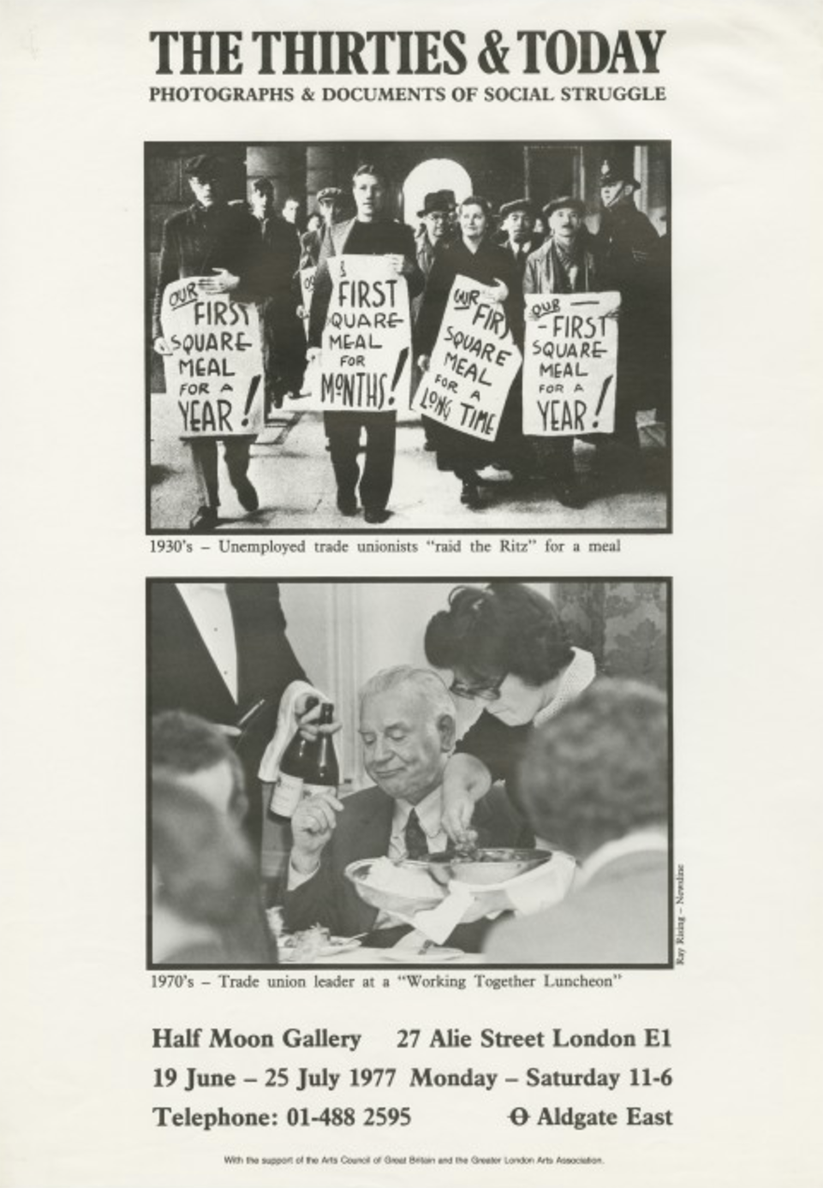
The perspective of women, both in front of, and behind, the camera, was highlighted in several exhibitions produced between 1974-1976. The exhibitions Women… a photographic exhibition (1974), Men Photographed by Women (1975), and Women: Who Are We? (1976) addressed the stereotyping and representation of women, critically examining their roles in the overlapping spheres of home and work in a period of radicalised feminist campaigning alongside the legislative changes of the Equal Pay Act of 1970, and the Sex Discrimination Act of 1975. Photographer Claire Schwob included women and childcare as a central theme in two of these early exhibitions, addressing the role of women as both mothers and workers, and the inherent inequalities of the patriarchal society described through photographs and text captions.
Following a callout for photographers to document women working in Hackney, the Hackney Flashers produced their first exhibition as a collective titled Women…Work in Hackney, commissioned by the Hackney Trades Union for its 75th anniversary in 1975. With members including the Half Moon Photography Workshop’s Jo Spence, the portable exhibition moved from Hackney Town Hall to the Half Moon Gallery, and later travelled to the Socialist Feminist International Conference, Paris in 1977. Although evidence suggests that this exhibition did not tour as part of HMPW’s regular touring programme, it highlights the pressing issues addressed by regular HMPW contributors through its mix of photographs and statistics, and highlights how the position of women in the workplace was beginning to be acknowledged by trade unionists, whose membership was still predominantly male.
Exhibition Poster for WOMEN a photographic exhibition by Maggie Murray, Sally Greenhill, Val Wilmer, Claire Schwob
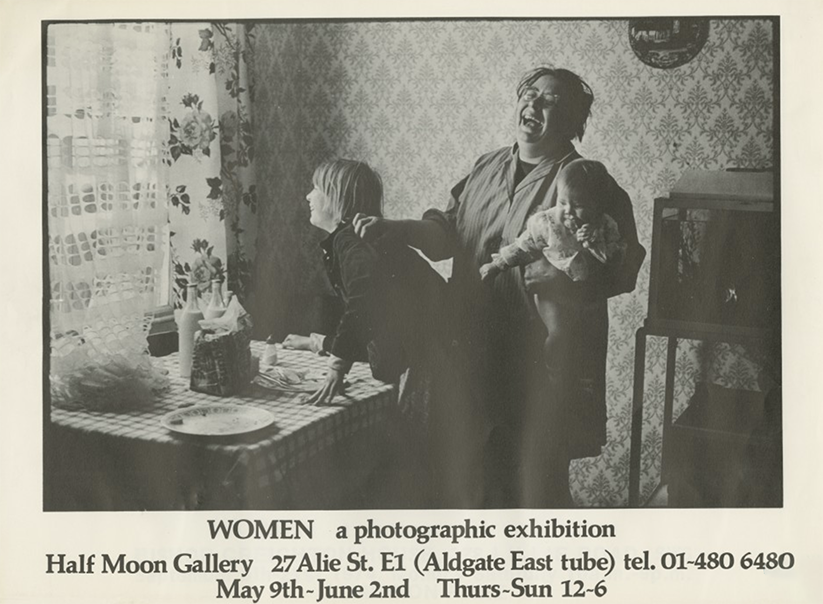
In addition to addressing the representation of women, touring exhibitions also considered the representation of Britain’s younger generations, with the work of child photographers forming part of the exhibition programme, as equal contributors. With children behind the camera, and new darkroom skills learnt through workshops run by the Blackfriars Photography Project, Doing Photography (1976) was produced. The exhibition showed work by 8–17-year-olds, offering an insightful account of family life, race and class from the point of view of the youngest in the community.
Exploring the perspectives of a marginalised group even within the young, an exhibition was created by students at the Linden Lodge School for sensory impairment. Visions of the Blind (1979), challenged assumptions around visual impairment, and the kinds of photographic work visually-impaired people could make. As project leader, Pierre Coutanche remarked in issue 13 of Camerawork, the project aimed to “break the social perimeters”. By encouraging visually-impaired children to explore photography, use cameras and display their work, the project presented the children’s unique view of the world. Tracing the movements of this exhibition reveals that hiring venues ranged from St. Paul’s Vicarage in Margate to the Ruhr Planning Authority in Germany, a venue that hired at least twelve exhibitions from the HMPW on a range of subjects from the sheep industry to life in Bethnal Green.
At the opposite end of the age spectrum Mike Abraham’s exhibition Growing Old (1977), challenged the stereotypes of older generations in Britain by considering how society restricted older people’s lives and experiences. With over 16 bookings, the ‘Growing Old’ exhibition proved popular at venues across the country including community centres, universities, galleries, bookshops and Holloway Prison’s education wing, demonstrating a shared concern for the welfare of the ageing population.
Campaigning on political issues was a major theme of the Half Moon Photography Workshop’s touring exhibitions. They focused on issues in Britain and abroad, such as A Document on Chile (1978), which explored the 1973 military coup and the authoritarian dictatorship in the country that followed. In the early 1980s, HMPW’s Ed Barber documented women campaigning at the Greenham Common women’s Peace Camp, established from 1982, that saw an estimated 30,000 women campaign against the RAF airbase holding US nuclear weapons. The recent discovery of a box of 35mm slides at the Four Corners Archive including documentation of the touring exhibition, Bomb Disposal: Peace Camps and Direct Action (1983), provides a visual record of some of the exhibition panels. This contributes to a clearer understanding of the format, content and message of Ed Barber’s exhibition, which saw women use their identity to raise questions about their children’s safety. Unity, support, and the message of peace are all visually identifiable in one exhibition panel that features a photograph of ‘Patchwork Power’, a patchwork banner sent by women in the USA, in support of the Greenham Common campaign, echoing the overall themes of Ed Barber’s exhibition. The Bomb Disposal poster caption states that this exhibition was part of the Greater London Council’s (GLC) Peace Year 1983, a Labour-led cultural programme that sought to promote London as nuclear-free through exhibitions, documentaries and events, challenging the Thatcher government’s promotion of nuclear weapons as a Soviet Union deterrent. This exhibition was also available to London Peace Groups for free, organised by the HMPW in collaboration with the GLC.
No Nuclear Weapons - Peter Kennard & Mike Abrahams, exhibition private view
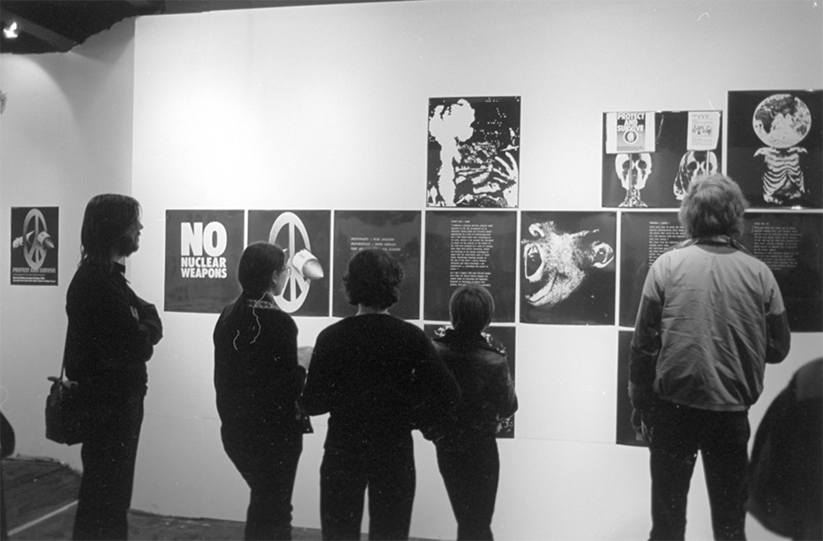
Bomb Disposal was not the only touring exhibition that contributed to the debate on nuclear disarmament. An earlier touring exhibition, No Nuclear Weapons (1980) by Peter Kennard and Mike Abrahams, also addressed this issue. Kennard’s visually striking photomontages and graphic text panels were accompanied by information on nuclear disarmament organisations. These exhibitions tapped into post-war Britain’s concerns about the use of these weapons, providing a platform for recording anti-nuclear campaigns, and an alternative narrative to the mainstream deterrent argument. Both exhibitions took multiple booking from different types of exhibition venues, demonstrating the then widespread concern over the UK’s nuclear deterrent programme. In the opening four weeks of Bomb Disposal at the Half Moon Photography Workshop’s new centre on Roman Road, it received a total of 1012 visitors and took on an additional 5 bookings, including for two arts venues - the Museum of Modern Art in Oxford and the Watershed, Bristol. No Nuclear Weapons, which had been touring since 1980, was still receiving regular bookings, with seven for the year, (which year?) demonstrating the ongoing importance of the exhibition.
By 1983, over forty exhibitions were available for hire, representing the themes outlined as well as other topics of identity, religion, education and industry. As a touring exhibition programme that was creating a dialogue around the important issues of the 1970s and 1980s, its significance is not only in its visual record of important issues, but that its physical form enabled different audiences to engage with the exhibitions across the country. Given the physical characteristics of these exhibitions, as sets of laminated panels, and their itinerant nature as they moved from venue to venue, few are known to have survived. The search continues to locate and record these important exhibitions as part of the ‘Hidden Histories’ project at Four Corners Archive.
Jayne Knight undertook a placement with Four Corners in 2022, as part of our ongoing collaboration with the University of Brighton.
The cover image for this article depicts the Gaining Momentum Exhibition exterior, 1981.
All images are available to view within our archive, alongside further information.